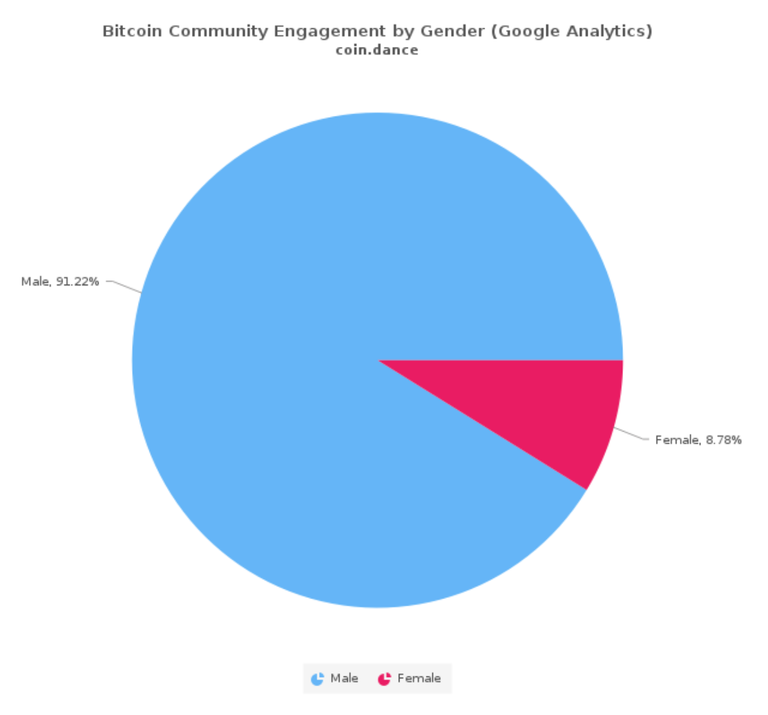
Guest post by Pauline Farris
Back in the early 2000’s, the “dot.com” bubble burst, and investors lost huge amounts. One of the interesting elements of that entire bubble was that it was an investment niche dominated by men. Women, for some reason, just didn’t take the risks involved. And while they were scoffed at for not investing, they had the last laugh.
Studies have shown that women who invest in markets — either for themselves or for organizations — are more cautious and risk-averse than men (and it should be noted that their approach tends to work well in terms of long-term income/revenue growth). We are witnessing the same phenomenon with cryptocurrencies as with the “dot.com” bubble. While anonymity is part of the attraction of investing in cryptos, there are surveys that point to a large underrepresentation of women. In fact, the latest Google Analytics result for the bitcoin gender divide, as reported in Coin Dance, is as follows:

Obviously, males “rule” this investment product. For those who remember the history of such investment gender divides, this should serve as a warning. On the other hand, there are those who predict that, over time, women will enter this investment market, for some clear reasons:
1. Cryptos are becoming more mainstream
Companies from a variety of sectors, as well as non-profits and even political campaigns, are now accepting Bitcoin payments. As early as 2014, Dell began to accept them as a legitimate source of payment. Most companies and organizations that accept payments do so through third-party services, as they facilitate the exchange between Bitcoin and fiat currencies. Among companies and organizations now accepting Bitcoin are: Steam, Save the Children, Shopify, Microsoft, Overstock, and eGifter. And this was as of the end of 2017.
2. Global Acceptance
Cryptos are moving into the global marketplace as a preferred method of international financial transactions. As companies continue to move into foreign markets, they will also begin to use cryptos and the blockchain technology that undergirds them in everything from smart contracts, to logistics, to payments. As Margaret Reid, content writer for The Word Point, a professional translation service, has pointed out: “We are seeing an increase in requests for contract translations from clients who are dealing in Bitcoin and who want to record and store those contracts in the Bitcoin blockchain. This is a growing sector of translations that is not going away.”
3. The Technology Holds Great Promise
While blockchain technology and cryptocurrencies are rather intimately tied to one another, the technology is now becoming recognized as having the potential to disrupt almost every economic sector. Because of its distributed ledgers of blocks that are immutable, there is the potential for security and fraud prevention that traditional technologies do not offer. Identities, contracts, purchases, shipments, personal records, and more can be stored in these blocks and provide permanent information and data that cannot be altered and only accessed by keycodes. The implications for government, insurance, travel, healthcare, education, and almost any business are huge. As everyone begins to recognize its potential, blockchain is becoming highly reputable. Interestingly, the cryptos that it undergirds are being pulled into reputable phenomena with it.
4. There are a Few Women Role Models
Iliana Oris Valiete is an accountant by profession. She moved into the Bitcoin market when it was fully new. Now working for Accenture on blockchain innovations, she has also made it her mission to encourage more females to move into the cryptocurrency investment market. According to Valiete, of the current ICO’s (initial coin offerings that are basically investment fundraising), about 13% are headed by females, and this represents good gender participation growth. She believes that these women will act as role models for the gender-mates, but that growth in female participation will still be rather slow.
So, Is It Good or Bad?
The debate continues on this one. And the verdict is certainly still out. Among those who are raising a red flag of alarm is Duncan Stewart, Research Director of Deloitte’s technology division in Canada. According to Stewart, just the fact that the gender divide is so large constitutes a bubble in itself. He further states that, throughout history, there is no such gender divide of this magnitude, in any stock or security, that has resulted in survival of that asset.
And yet, there are other considerations. First, when men get into an investment, they tend to share that investment potential and make recommendations to their “buddies,” usually men. And this may have factored in to the current gender divide. Couple that with the fact that the Bitcoin foundation Board of Directors is 100% male, and you have a rather “perfect storm” of male domination.
But bitcoin is still relatively new. And many certainly predict that it will become a critical currency whose use will only continue to grow, steadily and impactfully. As consumers continue to increase their use of Bitcoin to purchase legal products and services, and as it continues to be a valuable holding, women will increase their participation.
Time will tell. For now, Bitcoin remains a male “thing.” Whether it turns into another “dot.com” bubble or not is simply a matter of waiting and watching.
Pauline Farris speaks Portuguese, English, Spanish and Italian. She travelled the world to immerse herself in the new cultures and learn languages. Today she is proud to be a voting member of the American Translators Association and an active participant of the Leadership Council of its Portuguese Language Division.
@graft more articles will be?
You do not want to face the wrath of my bunghole!!
If you follow me, I will also follow you in return!
@graft, I gave you a vote!Enjoy some !popcorn courtesy of @nextgencrypto!